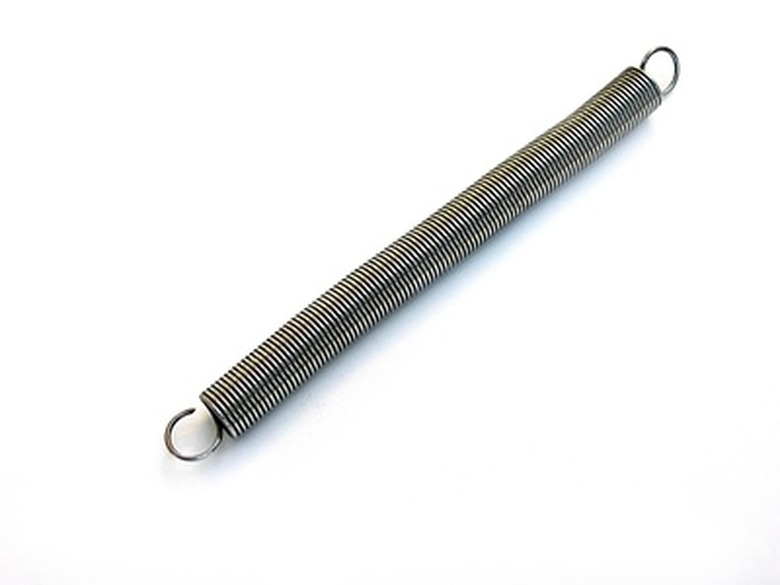How To Calculate Spring Constant
When you compress or extend a spring, it exerts a force opposite the force you exert in an effort to return to its equilibrium position. The amount of force is characteristic of the spring and is represented by the spring constant, k. According to Hooke's law, the relationship between extension x and force F is:
\(F = -kx\)
The minus sign signifies that the force exerted by the spring is in the opposite direction to the extension.
The relationship between force and extension is a linear one, which means that if you plot a force vs. extension graph, you'll get a straight line. It will pass through the origin (x = 0; F = 0), and its slope will be equal to the spring constant, k.
Convert to Force
Convert to Force
The easiest way to get values for a Hooke's law graph is to suspend the spring from a hook and attach a series of weights whose values are known. However, the weights are typically measured in grams or kilograms, which are units of mass. It's easy to convert them to units of force, though.
All you have to do is multiply the mass by the acceleration due to gravity, which in the MKS metric system is 9.8 m/s2 and in the CGS system is 980 cm/s2. If your weights are calibrated in pounds, multiply by 32 ft/s2 to convert them to pounds of force.
You can still get a graph with a straight line and extrapolate a value of k from the slope even if you don't make these conversions, but the value for k will be in the wrong units and will be a different value than the one you obtain if you do the conversion.
Plot Two Points or More
Plot Two Points or More
To plot a straight line, you only need two points, which means you only need to make two measurements. It's a good idea to make more, though – at least three or four. The extra measurements are insurance. If they don't fall on the line created by the original two points, something could be wrong with the spring or with the weights you're using.
To plot the points, suspend the spring vertically from a hook and record its extension, using a ruler. Attach a known weight to the free end and record the new extension. The difference is x. After you calculate the force exerted by the weight, you have your first point (x1, F1). Plot different points by changing the weight and recording the new extension. When you're done plotting points, draw a line through the points that is closest to touching all of them.
Measure the Slope of the Force Extension Graph
Measure the Slope of the Force Extension Graph
In general, you can find the slope of a line by choosing two points and forming a ratio of the rise and the run between these two points. If the first point you choose is (x1, F1), and the second point is (x2, F2), the slope of the line is:
\(\text{slope}=\frac{F_2 – F_1}{x_2 – x_1}\)
Assuming F2 is larger than F1.
This is the value of the spring constant, k. Despite the minus sign in the Hooke's law equation, k is a positive number, because the slope in the Hooke's law graph is positive.
Note that the spring constant has units of force/distance. In the MKS system, the spring constant units are newtons/meter. In the CGS system, they are dynes/centimeter. In the imperial system, they are pounds of force (lbf) /foot.
Now that you have the spring constant, you can predict exactly how much the spring will distend or compress when you subject it to any force.
Cite This Article
MLA
Deziel, Chris. "How To Calculate Spring Constant" sciencing.com, https://www.sciencing.com/calculate-spring-constant-7763633/. 1 February 2020.
APA
Deziel, Chris. (2020, February 1). How To Calculate Spring Constant. sciencing.com. Retrieved from https://www.sciencing.com/calculate-spring-constant-7763633/
Chicago
Deziel, Chris. How To Calculate Spring Constant last modified March 24, 2022. https://www.sciencing.com/calculate-spring-constant-7763633/
